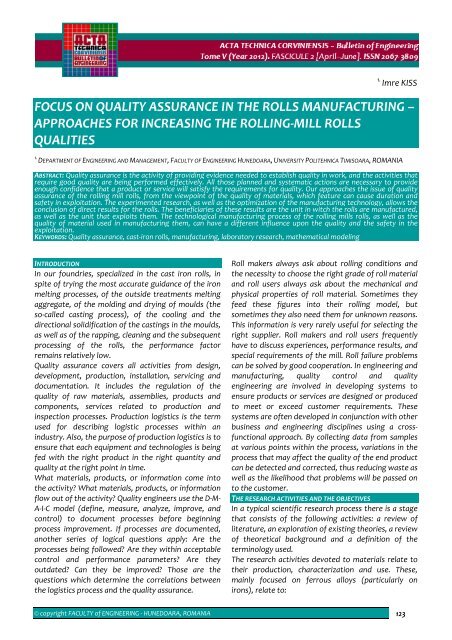Editorial & Advisory Board - Acta Technica Corviniensis
Editorial & Advisory Board - Acta Technica Corviniensis
Editorial & Advisory Board - Acta Technica Corviniensis
You also want an ePaper? Increase the reach of your titles
YUMPU automatically turns print PDFs into web optimized ePapers that Google loves.
1.<br />
Imre KISS<br />
FOCUS ON QUALITY ASSURANCE IN THE ROLLS MANUFACTURING –<br />
APPROACHES FOR INCREASING THE ROLLING‐MILL ROLLS<br />
QUALITIES<br />
1.<br />
DEPARTMENT OF ENGINEERING AND MANAGEMENT, FACULTY OF ENGINEERING HUNEDOARA, UNIVERSITY POLITEHNICA TIMISOARA, ROMANIA<br />
ABSTRACT: Quality assurance is the activity of providing evidence needed to establish quality in work, and the activities that<br />
require good quality are being performed effectively. All those planned and systematic actions are necessary to provide<br />
enough confidence that a product or service will satisfy the requirements for quality. Our approaches the issue of quality<br />
assurance of the rolling mill rolls, from the viewpoint of the quality of materials, which feature can cause duration and<br />
safety in exploitation. The experimented research, as well as the optimization of the manufacturing technology, allows the<br />
conclusion of direct results for the rolls. The beneficiaries of these results are the unit in witch the rolls are manufactured,<br />
as well as the unit that exploits them. The technological manufacturing process of the rolling mills rolls, as well as the<br />
quality of material used in manufacturing them, can have a different influence upon the quality and the safety in the<br />
exploitation.<br />
KEYWORDS: Quality assurance, cast‐iron rolls, manufacturing, laboratory research, mathematical modeling<br />
INTRODUCTION<br />
In our foundries, specialized in the cast iron rolls, in<br />
spite of trying the most accurate guidance of the iron<br />
melting processes, of the outside treatments melting<br />
aggregate, of the molding and drying of moulds (the<br />
so‐called casting process), of the cooling and the<br />
directional solidification of the castings in the moulds,<br />
as well as of the rapping, cleaning and the subsequent<br />
processing of the rolls, the performance factor<br />
remains relatively low.<br />
Quality assurance covers all activities from design,<br />
development, production, installation, servicing and<br />
documentation. It includes the regulation of the<br />
quality of raw materials, assemblies, products and<br />
components, services related to production and<br />
inspection processes. Production logistics is the term<br />
used for describing logistic processes within an<br />
industry. Also, the purpose of production logistics is to<br />
ensure that each equipment and technologies is being<br />
fed with the right product in the right quantity and<br />
quality at the right point in time.<br />
What materials, products, or information come into<br />
the activity What materials, products, or information<br />
flow out of the activity Quality engineers use the D‐M‐<br />
A‐I‐C model (define, measure, analyze, improve, and<br />
control) to document processes before beginning<br />
process improvement. If processes are documented,<br />
another series of logical questions apply: Are the<br />
processes being followed Are they within acceptable<br />
control and performance parameters Are they<br />
outdated Can they be improved Those are the<br />
questions which determine the correlations between<br />
the logistics process and the quality assurance.<br />
Roll makers always ask about rolling conditions and<br />
the necessity to choose the right grade of roll material<br />
and roll users always ask about the mechanical and<br />
physical properties of roll material. Sometimes they<br />
feed these figures into their rolling model, but<br />
sometimes they also need them for unknown reasons.<br />
This information is very rarely useful for selecting the<br />
right supplier. Roll makers and roll users frequently<br />
have to discuss experiences, performance results, and<br />
special requirements of the mill. Roll failure problems<br />
can be solved by good cooperation. In engineering and<br />
manufacturing, quality control and quality<br />
engineering are involved in developing systems to<br />
ensure products or services are designed or produced<br />
to meet or exceed customer requirements. These<br />
systems are often developed in conjunction with other<br />
business and engineering disciplines using a crossfunctional<br />
approach. By collecting data from samples<br />
at various points within the process, variations in the<br />
process that may affect the quality of the end product<br />
can be detected and corrected, thus reducing waste as<br />
well as the likelihood that problems will be passed on<br />
to the customer.<br />
THE RESEARCH ACTIVITIES AND THE OBJECTIVES<br />
In a typical scientific research process there is a stage<br />
that consists of the following activities: a review of<br />
literature, an exploration of existing theories, a review<br />
of theoretical background and a definition of the<br />
terminology used.<br />
The research activities devoted to materials relate to<br />
their production, characterization and use. These,<br />
mainly focused on ferrous alloys (particularly on<br />
irons), relate to:<br />
© copyright FACULTY of ENGINEERING ‐ HUNEDOARA, ROMANIA 123

















